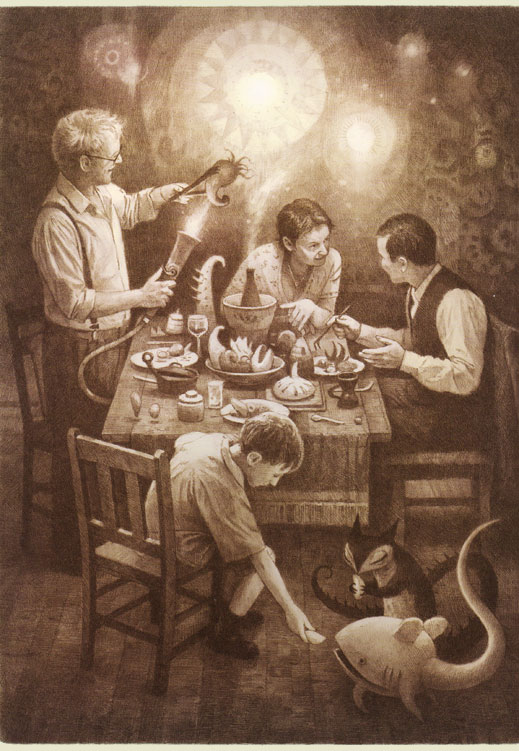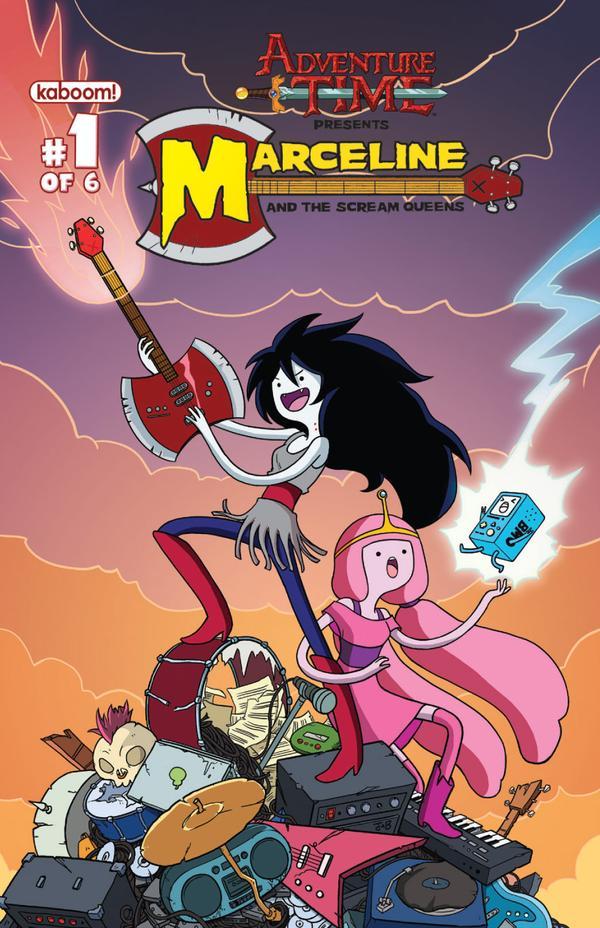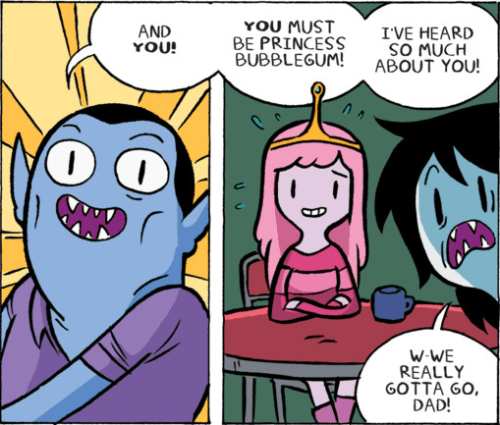Sunday, April 21, 2013
The Arrival Rewrite
Revisiting The Arrival by Shaun Tan, it is even more apparent how incredibly unique this comic is. Almost every panel could be it's own work of art and the fact that this novel is filled with hundreds of fully rendered drawings is just astounding. The rich details of the art bring you into this bizarre new world along with protagonist. The pacing of the novel is also much more even than in other comics. Most pages just have rows of the same neat identical squares placed side by side. It gives the story a sense of routine. A feeling that the events happening are just part of daily life in this new land. While the father in this story is overwhelmed by how vastly different this new place is, he eventually is able to find his own place in society. he becomes a part of the everyday. The panels in the The Arrival are either the repetitive small squares or very large full page images. These are almost always used to establish the setting on an grand scale.
Something else that I noticed was the bookending pages in the novel that list off the things found in the man's room. On the first page the items are all easily recognizable and common. We understand objects like origami birds and cups of coffee because they are objects from our world. They are within our frame of reference. In this story we are the father and we are experiencing this journey through his eyes. Near the end of the novel there is a page that harkens back to this list of objects in the room. On this page are the objects the man has assimilated into his daily routine now that he lives in this new world. The paper bird is now a paper dog creature that resembles the monster that became his first friend upon arrival. He now has a bowl of tentacles to eat and his cup of coffee has an uncurled handle. There are two constants between these images and those are a the man's hat and coat and a picture of his family all together. This shows that no matter where we are in the world, the importance of family never dies. Family will keep you grounded and give you something to live for regardless of where you live. The picture of the coat and the hat is an example of how we mix and match our cultural influences. Even though this man lives in a new country he still maintains the sense of style that he is accustomed to. His clothing finds a place even though it is surrounded by foreign objects. This is the result of the melting pot that allows new traditions and customs to grow in a society.
The Arrival is a story of hard work paying off. It gives you a sense of hope and peace in the end with the family able to survive in their new home. By the end of the book they are part of society, so much so that they are able to take on the responsibility of helping new immigrants find their way.
Paradise Kiss
Spending
two weeks on Manga gave me a chance to try reading different stories in a genre
that I tend to avoid. Paradise Kiss is a shojo manga by Ai Yazawa that exemplifies all the
reasons why I tend to find shojo so insufferable. Something that is very common
in girl comics are main characters who are over emotional and spastic. In
Paradise Kiss, Yukari fits into this mold as the young college student who just
wants to do well in school. Throughout the comic she goes from panel to panel
jumping from one extreme emotion to the next. One second she’ll be crying over
not passing an exam and the next page she’s getting a nose bleed over a hot
guy. Maybe the heightened emotions found in Manga are a way for the Japanese to
overcompensate for a society where people tend to be quieter and to themselves.
While reading the story I can just hear the characters screaming from panel to
panel and it quickly gets exhausting. I'm can see why this genre is so appealing to young teenage girls. It's wish fulfillment with plenty of romance and I'm sure this style would make more sense to me if I had read it earlier in my life.
Yukari essentially lives what I’m sure many girls would consider a desirable fantasy of being discovered by young fashion designers to be runway model. Though she is hesitant and insecure at first, modeling eventually gives Yukari newfound confidence. The way all the melodrama is presented in the comic is so over the top but this is only because I am not used to this style of comic. For instance, when Yukari is looking out a window contemplating if she should be a part of a fashion show she is sitting in shadow and a huge beam of line emits from her forehead. When the bisexual fashion student George appears he tends to be standing in front of a background of flowers, signifying how attractive he is. The issue reads like a romantic comedy as the romance between Yukari and George rolls along with will they/won’t they sexual tension until the issue ends with an expected kiss. This book is tries to incorporate a lot of female fantasy into the narrative. Anchoring the story around a fashion school allows for a lot of elaborate costumes and dresses. The characters identify themselves by their appearance. If anything it’s setting that is very visual and appropriate for a comic narrative.
Yukari essentially lives what I’m sure many girls would consider a desirable fantasy of being discovered by young fashion designers to be runway model. Though she is hesitant and insecure at first, modeling eventually gives Yukari newfound confidence. The way all the melodrama is presented in the comic is so over the top but this is only because I am not used to this style of comic. For instance, when Yukari is looking out a window contemplating if she should be a part of a fashion show she is sitting in shadow and a huge beam of line emits from her forehead. When the bisexual fashion student George appears he tends to be standing in front of a background of flowers, signifying how attractive he is. The issue reads like a romantic comedy as the romance between Yukari and George rolls along with will they/won’t they sexual tension until the issue ends with an expected kiss. This book is tries to incorporate a lot of female fantasy into the narrative. Anchoring the story around a fashion school allows for a lot of elaborate costumes and dresses. The characters identify themselves by their appearance. If anything it’s setting that is very visual and appropriate for a comic narrative.
Scott Pilgrim
It's no surprise that this series of comics is so popular with people in our generation. It mashes together two very popular aspects of "geek" culture: manga and video games and combines them with sharp writing and an adorable big eyed cartoon style. The book is printed like a Japanese manga despite that fact that the story and artist are very Canadian. The heavy manga influence can also be found in the extreme expressions that pop onto the characters and the action lines that appear behind them when emotions run high. The videogame influence can be found in both the style of writing in the novel and the plot itself. Scott wants to date the mysterious and extremely sarcastic Ramona Flowers but can only be with her if he defeats her 7 Evil Exes.
The battle in the first book happens completely out of the blue and Scott begins fighting as if he's a hero in an action game. The fight against Matthew Patel is like a boss battle, he throws an array of showy moves and tricks at Scott to try to defeat him but in the end Scott wins Here's the first battle from the very true to the source film adaptation. You can tell from the movie clip how the film was able to capture the derivative nature of the comics. In this one 90 seconds clip you get references to a Bollywood style musical number, punk rock imagery of the floating goth girls, and fire ball hands straight out of Dragon Ball Z. Patel turns into a handful of coins when he is defeated, much like a common reward found in most video games. A lot of the humor of the book comes from the contrast between Scott's completely average life as a broke 23 year old and this larger than life situation he finds himself in. Scott is a normal dude and it says a lot about his character that he is completely unfazed at the thought of having to defeat all these exes, so long as he gets to make out with his hot new girlfriend. The relationships are really what drive the story. Scott has to learn to deal with every aspect of dating throughout the story: The excitement of having a new crush, dealing with a resentful ex, the awkward attempts at being friends with an ex, and how immensely difficult it is break up with someone without feeling like an awful person. In the end Ramona's evil exes are no different than the past relationship baggage you have to deal with when going out with someone new.
Good Bye Chunky Rice
"Good Bye Chunky Rice" is Craig Thompson's first graphic novel. It's the tale of small tea turtle who decides to leave his home and his best friend/ (girlfriend?), Dandel the mouse, in search of something more. The novel begins with Dandel and Chunky enjoying a day at the beach. Chunky is leaving the next day and is worried about saying good bye to his best friend. She assures him that he has so much to see in the world. There is a theme of loss and longing that permeates the entire novel and gives the book a very somber feeling. The main characters are adorable, small cartoon animals and yet the emotions they evoke are so poignant. There is a scene after Chunky leaves when Dandel is on the beach. Now alone, she watches the crashing waves and says,
The feeling is heartbreaking and completely relatable. The emotions are heightened by the drawings of a poor little mouse curled up so tightly amongst the endless dark ocean. Loss is something everyone is dealing with on the ship. Livonia hasn't been able to sleep since she lost her favorite teddy bear and the ship's captain is morning the loss of his wife Glenda. Chunky deals with regret as he keeps questioning whether he made the right choice to leave. In the end the power of Dandel's determination and friendship by never giving up on contacting her friend brings Chunky a sense of hope. The novel ends with him finding one of her bottles while she's on the beach saying "There is no Good-bye, Chunky Rice."Friendship is driving force of happiness in this novel and it's the thing that everyone is trying to achieve in their various quirky ways. The art style is appealing with a cast of slightly bizarre characters. This is a world where no one bats an eye at a talking animal but none of that hinders the believeableity of these characters and their problems. The emotional impact in this short tale really packs a punch because the act like real people.
Marceline and the Scream Queens
I read the entire Marceline and the Scream Queens series this week and I found it especially interesting when looking at it through the context of fandom. The comic is a spin off of the very popular Adventure Time comics, which are based off of the even more popular cartoon show on Cartoon Network. Adventure Time is a series about two best friends, a boy and his dog, who go on strange, fantastic adventures. The show's mix of humor, action, and at times poignant drama has lead to an enormous fan base that includes just as many older viewers as young children. The internet fan community for Adventure Time is very expansive and there are hundreds and hundreds of fan works based on the show online.
The show's popularity lead to an expansion of the story by the means of a comic book series. This is a very common practice in the world of comics, especially with series that have a very prolific "cult" fan bases who are more inclined to read comic books. For example even though it finished it's run on television in 2003, Joss Whedon has continued the story of Buffy the Vampire Slayer well into it's 8th and 9th seasons through monthly comics published by Dark Horse. Comic book publishers are more likely to publish series based on television and movie franchises because of their pre-established fan bases. Not only is Adventure Time a popular comic series, but the creators also take in a lot of input from fans to see which characters and stories would be the most popular.
Marceline and the Scream Queens is a 6 part series that spawned from the large popularity of two main characters from Adventure Time: Marceline the Vampire Queen and Princess Bubblegum. The story of the comics follows Marceline and her band as they go on their first tour across the Land of Ooo. Marceline is the artistic voice of the band while Bubblegum is the band's manager, booking shows and making sure everyone in the band is getting along. The two girls are very different and constantly bud heads over which direction the band should go in, but over the course of the series they learn to understand each other and become good friends. The stories are fun and simple and the art has the same bright and expressive style of the cartoon. It's fun to see these characters be the star of their own story lines. The Adventure Time T.V. show mainly follows the adventures of Finn and Jake with other characters getting one off episodes here or there so it's nice to read a story focusing on these two girls. These more specific stories are perfect for the world of comics because they are faster to produce than the television show and they are able to give fans exactly what they want. The comics were written and illustrated by Meredith Gran who is most well known for her web comic "Octopus Pie". The artist both stays true to the style of Adventure Time while also adding in her own artistic charm which makes for a very appealing story.
The fandom influence of the comics can be found in the subtext sprinkled in throughout the series. There is a very large group of fans online who “ship” the characters Marcline and Bubblegum together. The couple has been addressed by the creators of Adventure Time and one of the show’s character designers, Natasha Allegri, has even posted her own fan art of the pair. The subtext is a fun little wink to fans who want to make it into something more while being subtle enough where it isn’t a distraction. This is just one of many examples of fandom influencing comic books and I’m sure it’s something that will continue to happen more and more with the internet bringing fans and content creators in easy contact. There are even more Adventure Time Comic spin offs in the works, proving the success of a short series like Marceline and the Scream Queens.
Subscribe to:
Posts (Atom)





